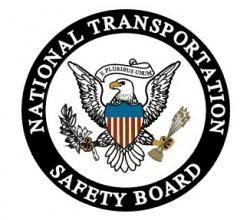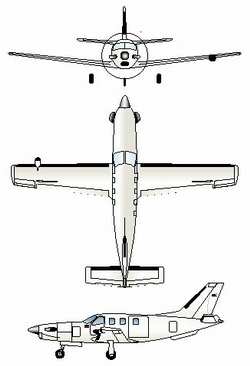Seeing PART Of The Runway Can Be Deceptive
 The transition from IFR to VFR can be difficult... especially
when the IFR conditions don't want to give up. Cancellation of an
IFR appraoch by a TBM pilot went astray when the runway environment
turned out to have a lot less visibility than the pilot had
estimated. The NTSB Prelim tells the story of how one pilot got
into trouble under these circumstances...
The transition from IFR to VFR can be difficult... especially
when the IFR conditions don't want to give up. Cancellation of an
IFR appraoch by a TBM pilot went astray when the runway environment
turned out to have a lot less visibility than the pilot had
estimated. The NTSB Prelim tells the story of how one pilot got
into trouble under these circumstances...
NTSB Identification: WPR10LA082
14 CFR Part 91: General Aviation
Accident occurred Sunday, December 13, 2009 in Truckee, CA
Aircraft: EADS SOCATA TBM 700, registration: N850MT
Injuries: 2 Uninjured.
This is preliminary information, subject to change, and may contain
errors. Any errors in this report will be corrected when the final
report has been completed.
On December 13, 2009, about 1738 Pacific standard time, a EADS
Socata TBM-700 airplane, N850MT, was substantially damaged when it
impacted terrain near the Truckee-Tahoe Airport, Truckee,
California, following an aborted landing. The airplane was
registered to Tahoe Investments, Los Altos Hills, California, and
operated by the pilot under the provisions of Title 14 Code of
Federal Regulations Part 91. The instrument rated private pilot and
his passenger were not injured. Instrument meteorological
conditions prevailed and an instrument flight rules (IFR) flight
plan was filed for the cross-country flight. The flight originated
from the San Carlos Airport, San Carlos, California, at 1630 with
an intended destination of TRK.
 In a written statement, the pilot reported that prior to the
flight, he obtained the weather conditions at TRK numerous times.
He recalled that prior to departure, the cloud condition at TRK was
a broken cloud layer at 3,000 feet, visibility 7 miles, calm winds,
and that Runway 19 was closed. During the flight, he monitored the
weather conditions at TRK and decided to conduct the Global
Positioning System (GPS) Runway 19 instrument approach. As the
pilot initiated the instrument approach, he continued to monitor
the weather conditions at the airport and noted that the visibility
had decreased to 7 miles. The pilot stated that during the
approach, the airplane “…picked up some light rime
ice” and he turned on all of the airplane's deicing
equipment. The pilot was unsure at what altitude the airplane
“broke out” of the clouds, due to the ground being
visible throughout the approach. As the airplane approached the
published missed approach point, the pilot established visual
contact with the runway lighting for Runway 28 and canceled his IFR
clearance. As he entered a left downwind for Runway 28, the pilot
noticed “…the first part of 28 was covered in
fog.” The pilot checked the reported weather conditions via
the Automated Surface Observation System (ASOS) located at TRK and
noted that the visibility was three-quarters of a mile with light
snow.
In a written statement, the pilot reported that prior to the
flight, he obtained the weather conditions at TRK numerous times.
He recalled that prior to departure, the cloud condition at TRK was
a broken cloud layer at 3,000 feet, visibility 7 miles, calm winds,
and that Runway 19 was closed. During the flight, he monitored the
weather conditions at TRK and decided to conduct the Global
Positioning System (GPS) Runway 19 instrument approach. As the
pilot initiated the instrument approach, he continued to monitor
the weather conditions at the airport and noted that the visibility
had decreased to 7 miles. The pilot stated that during the
approach, the airplane “…picked up some light rime
ice” and he turned on all of the airplane's deicing
equipment. The pilot was unsure at what altitude the airplane
“broke out” of the clouds, due to the ground being
visible throughout the approach. As the airplane approached the
published missed approach point, the pilot established visual
contact with the runway lighting for Runway 28 and canceled his IFR
clearance. As he entered a left downwind for Runway 28, the pilot
noticed “…the first part of 28 was covered in
fog.” The pilot checked the reported weather conditions via
the Automated Surface Observation System (ASOS) located at TRK and
noted that the visibility was three-quarters of a mile with light
snow.
The pilot further reported that he “…saw at least
5,000 feet of clear runway” and “…decided to
land just beyond the fog.” Just prior to touchdown, the pilot
“…decided I didn’t have enough runway left to
land and decided to go around.” He applied power, pitched up,
and retracted the landing gear. The pilot stated that he
“…heard a warning horn, which I thought was because I
had failed to raise the landing flaps before lifting the gear. When
the horn didn’t stop and [the airplane] wasn’t
climbing, I pitched the nose down. I then only saw snow and trees
ahead and decided I couldn’t climb over the trees. I focused
on avoiding trees and leveling the wings.” Subsequently, the
airplane impacted trees and terrain about 0.5 miles northwest of
the departure end of Runway 28.
Examination of the airplane by a Federal Aviation Administration
(FAA) inspector revealed that the airplane came to rest upright
within a wooded snow covered field. The left and right wings were
structurally damaged. The propeller assembly was separated from the
engine and located adjacent to the main wreckage. A strong odor of
jet fuel was also present at the accident site. The airplane was
recovered to a secure location for further examination.
 Senator Pushes FAA to Accelerate Rocket Launch Licensing
Senator Pushes FAA to Accelerate Rocket Launch Licensing Classic Aero-TV: RJ Gritter - Part of Aviations Bright New Future
Classic Aero-TV: RJ Gritter - Part of Aviations Bright New Future Aero-FAQ: Dave Juwel's Aviation Marketing Stories -- ITBOA BNITBOB
Aero-FAQ: Dave Juwel's Aviation Marketing Stories -- ITBOA BNITBOB ANN's Daily Aero-Linx (10.27.24)
ANN's Daily Aero-Linx (10.27.24) ANN's Daily Aero-Term (10.27.24): Clearance Void If Not Off By (Time)
ANN's Daily Aero-Term (10.27.24): Clearance Void If Not Off By (Time)




